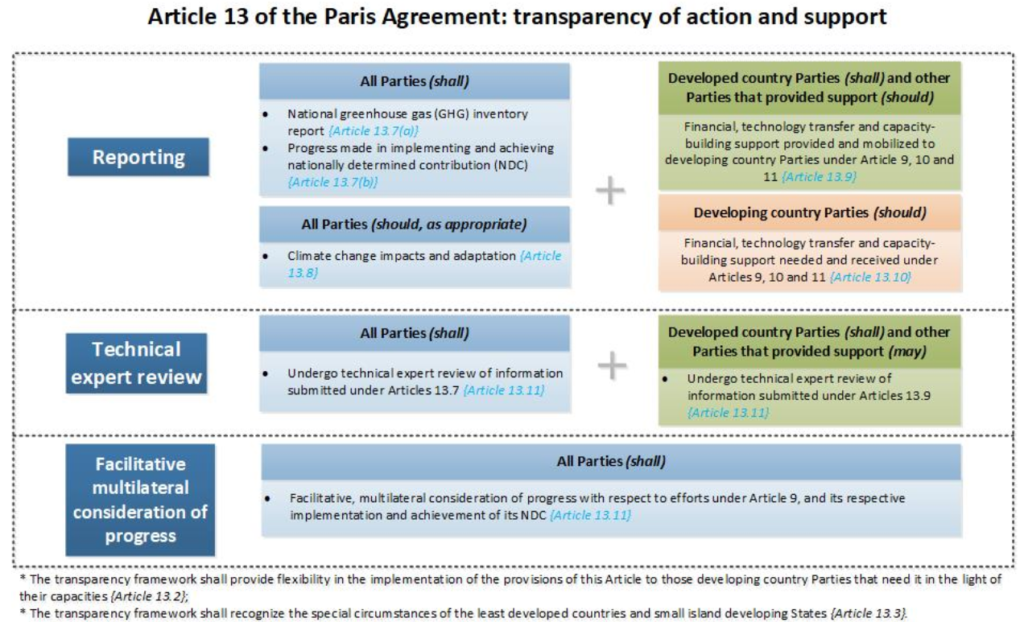Overview of UNFCCC guidance for MRV systems
MRV stands for measurement, reporting and verification. MRV of greenhouse gas (GHG) describes the process of measuring (and monitoring) GHG emissions; compiling and reporting this information to a system, program or body; and then subjecting this reported data to a party review and verification process.
The scope of an MRV system depends on the user and goal. It may include, for example, MRV of GHG emissions (e.g., emission inventory), MRV of mitigation actions (e.g., policies and projects), MRV of support (e.g., climate finance and capacity building) or MRV of other impacts, such as gender (Box 1).
| Box 1. Types of mitigation-related MRV |
|---|
| MRV of GHG emissions, conducted at national, organizational, or facility level is used to understand an entity’s emissions profile and report it in the form of an emissions inventory. ▪ MRV of mitigation actions (e.g., policies and projects) is used to assess policy and project effect on GHGs and sustainable development (non-GHG) and to monitor their implementation. This type of MRV focuses on estimating the change in GHG emissions or other non-GHG variables. ▪ MRV of support (e.g., climate finance, technology transfer, and capacity building) is used to track provision and receipt of climate support, monitor achieved results, and assess impact. Source: Singh et al. 2016 |
The term MRV originally came from the Bali Action Plan, the negotiating text of the UNFCCC (UNFCCC, 2007) in Bali, Indonesia at the end of 2007. The basic understanding of the Bali Action Plan is that climate change mitigation actions—mainly reduction of GHG emissions—shall be implemented in a “measurable, reportable and verifiable” manner.
The UNFCCC provides official guidance for measurement (or estimation), reporting, and verification of GHG emissions and mitigation actions at the national level. The guidelines for measuring and reporting GHG emissions to the UNFCCC are well established. Verification processes differ depending on the type of report.
The UNFCCC and Paris Agreement expect developing country parties to measure (or estimate) the effects of domestically and internationally supported mitigation actions (such as Nationally Appropriate Mitigation Actions (NAMA) and Nationally Determined Contributions (NDC)). This type of MRV is voluntary, and there are no prescriptive guidelines. Countries are expected to create their own systems according to their circumstances and priorities. This has allowed more flexibility but has also created confusion as to what constitutes MRV of mitigation actions and what minimally acceptable practices might be (Box 2).
The 2015 Paris Agreement added two new layers to the UNFCCC MRV framework:
- the need to report progress on NDCs, and
- the establishment of an Enhanced Transparency Framework intended to supersede prior procedures and guidelines for MRV.
| Box 2. Overview of UNFCCC MRV requirements for developing countries (prior to the Paris Agreement) |
|---|
| ▪ Measurement (M) for non-Annex I Parties applies both to efforts to address climate change and to the impacts of these efforts. It occurs at the national level and refers to GHG emissions, mitigation actions and their effects, and the support needed and received. ▪ Reporting (R) for non-Annex I Parties is implemented through the national communications and Biennial Update Reports (BURs), where Parties report on their actions to address climate change in their national communications. ▪ Verification (V) is addressed at the international level, through International Consultation and Analysis of BURs. It can also occur at the national level, but this is voluntary. Source: UNFCCC Support for Developing Countries |

